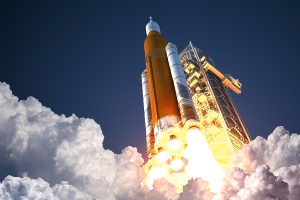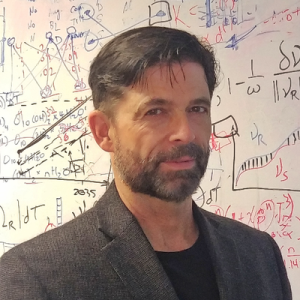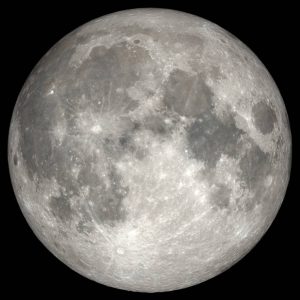Planetary Researcher’s Innovations Help Pave the Way for Economic Activity Beyond Earth
April 2024
By Kathleen Snoeblen
Imagine UCF researchers living and working on the moon, companies mining and using its resources to launch rockets further into space. That’s what UCF’s Philip Metzger, Ph.D., predicts in the not-too-distant future. “Within a few decades, that’ll be a real thing when you look at the trajectory of the space industry and how access to space is becoming less costly. Even transportation to the moon is about to be revolutionized,” Metzger said. The Director of The Stephen W. Hawking Center for Microgravity Research and Education (The Hawking Center), Metzger, has developed inventions to meet those predictions and hopefully relieve the Earth of some environmental burdens.
With almost 30 years of experience at NASA, Metzger has been helping to make the dream of space travel a reality. The planetary scientist started as part of the Space Shuttle team right out of college. After retiring early, he joined the UCF Florida Space Institute in 2014 and became The Hawking Center director in late 2023. His research includes studies of extraterrestrial soil mechanics, characterizing lunar and Martian soil simulants, and modeling the migration of space equipment in the airless and microgravity environment.
When asked what he thinks industry in space will look like, Metzger gave an unexpected answer. “Some people think you can move most of industry into space and then bring manufactured goods back down from space. I don’t think that’s a very viable idea. I could be wrong,” he said. “Instead, it would be better to put computing and power generation into space. You can beam clean energy down from space, and you can beam data down from space.”
He explained that computer growth on Earth will prove to be an energy hog. “Computing is growing exponentially, especially with artificial intelligence,” he said. “Within a few decades, more energy will be spent computing than everything else combined. So, by moving computing off the Earth into space, we can reduce our environmental burden on the planet,” he noted.
“We also want to reduce the number of rocket launches because rocket launches harm the atmosphere,” Metzger said. He thinks that 10-20 years from now, we could be launching 12 giant rockets a day. “That will be above the limit―where it is harming the atmosphere. We can reduce that by about a factor of 10 if we start using resources on the moon and asteroids and launching rockets from those locations,” he advised. “We can protect Earth’s atmosphere by using resources in space.”
With that in mind, Metzger recently led the development of inventions that will help to cost-effectively gather, use, and manage such resources as ice (for water and fuel) and soil (for building materials).
Extracting Lunar Ice for Water and Fuel
“Aqua Factorem!” Sound familiar to you J.K. Rowling/Harry Potter fans? That’s the name that Metzger and his team gave the first invention. A patented, low-cost system for extracting water from the moon, the innovation paves the way for companies to operate facilities in space by harvesting and using the moon’s resources.
More than a decade ago, NASA discovered that the shadowy craters of the moon contained ice, metals, and other valuable materials to support further space exploration. At that time, Metzger and other researchers started studying ice on the moon. “A lot of different people were proposing ways to get the ice out of the soil to make rocket fuel,” he said.
Through the years, Metzger said that a key obstacle has always been the amount of power needed to harvest and convert those resources into water, fuel, and even air. “It takes huge amounts of power to go down into these craters,” Metzger said. “And how do you get the power down into these dark craters on the moon? We were looking at things like beaming energy with lasers or gigantic mirrors to reflect the sunlight.
“One day, I was thinking about the physical state of the ice in the lunar soil and realized that it’s granular, you know, grains of ice mixed in the soil rather than ice coating the grains of soil.” Based on that geological insight, Metzger developed and led a NASA-funded study on methods for getting the ice out of the soil much less expensively. “Rather than heating it until it vaporizes in a lunar vacuum, catching the vapor, and then refreezing it, we could simply sort the grains using several processes,” he said.
“I proposed that we could reduce the energy by about 99 percent, and our study showed that we can reduce the power by 98.3 percent. Pretty darn good,” he said proudly. “So that means you don’t need these expensive types of energy systems. Instead, you can simply use fuel cells and just drive the fuel cells in and out of the craters.”
The fuel cells would be regenerable. “Using sunlight, you split water into hydrogen and oxygen, and then you get the energy back by letting the hydrogen and oxygen recombine across a membrane,” Metzger said. “That fuel cell then drives the equipment in the crater from which you’re getting more water and bringing it back out again. The water also becomes your medium for transporting the energy to run the whole operation.”

Figure 2. According to Dr. Metzger, using the moon’s resources for rocket fuel could help reduce the number of Earth’s rocket launches and in turn, help to protect its atmosphere. Image: Adobe Stock.
In an example use of Aqua Factorem, Metzger said that a lunar rover could carry the device into one of the dark craters and set it on the ground. The rover would dig up soil that contains ice (essentially asteroid and comet residue) and place it into the device, which would then separate the ice from the soil. Later, another rover would get the ice and drive it outside the dark crater to a processing station in the sunlight. “You would clean up the ice, electrolyze it, and then chill that down to liquid hydrogen and liquid oxygen for rocket fuel,” Metzger said. In that scenario, a lander would transport the rocket fuel off the moon to a spacecraft to provide a boost service and then fly back and land on the moon on one tank of gas.
“We proved it can do that and then refuel and do it again,” he said. “You’re providing a method to boost spacecraft from the moon instead of launching rocket fuel from the Earth.” Metzger noted that the operation reduces the energy required to harvest ice on the moon and would be profitable. It would also benefit the Earth’s atmosphere and environment by reducing the number of launches.
“We quantified how much energy the whole thing would require and how big the solar cells would have to be,” he said. The team’s analysis of all the different system components, their power, mass, and cost of making everything showed a viable architecture, relying only on the moon’s resources. With that, Metzger said the technology has drawn the interest of at least 100 companies, many looking to mine the moon and asteroids.
As for the invention’s name, Metzger asked colleagues at the Florida Space Institute for ideas. “Somebody said, why don’t you name it like in Harry Potter, one of those spells? Like Wingardium Leviosa?” So, the team looked up Latin words for “water makers” and named the invention Aqua Factorem. “It’s like magic because you pour in the soil, and it [the system] magically separates the ice grains from the soil grains,” he said.
For more information about the invention, see the technology sheet and the Aqua Factorem YouTube video.
Sintering Lunar Soil for Building Projects on the Moon
Metzger’s work on the ice extraction problem led to the next invention, a method for sintering lunar soil for construction materials. During the Aqua Factorem research, Metzger and his team ran experiments to magnetically separate the moon’s soil and ice. “To sort the lunar sand grains from the ice grains, we use a combination of magnetic and electric vibration or electrostatics.
“We showed that it’s very efficient. You can get a high rate of flow of the soil through the magnetic field and get good separation,” he said.
At that time, he recalled a study he had done at NASA’s Jet Propulsion Laboratory (JPL) years earlier. “In that study, one of the tasks that the team wanted me to do was figure out the best way to build a landing pad on the moon,” he said.
In the JPL study, Metzger found several ways to build landing pads. “Sintering, spraying polymer on the soil to stick the soil together, baking the soil in an oven to make pavers.” He even considered using microwaves, but that required too much energy. The JPL team eventually found that the cost of the power and equipment on the moon was not competitive.
“And so again, it came down to finding a way to do it with less energy,” he said. “That was when I realized if we magnetically sort the sand, the magnetic soil can absorb microwaves better than the nonmagnetic soil.
“It seemed highly likely that the more magnetic soil would absorb the microwaves better, so that was my hypothesis,” Metzger said. Based on that, he and the UCF team sought and obtained funding, performed experiments, and proved that the new process could reduce the power by 70 percent.
He also analyzed actual lunar soil, studying the microwave susceptibility and the magnetic susceptibility of all the different minerals and glass in the soil. “I created a model that predicts that if you used real lunar soil, you would indeed reduce the energy by 70 percent,” he said. The model nearly matched the experimental results. After that came an economic analysis. “It showed that the cost of building a landing pad on the moon could be reduced by several hundred million dollars by using this process,” he said with a smile.
Metzger described the process for making a viable, affordable landing pad using the moon’s resources. “You scoop up the soil and run it through a magnetic field to separate the nonmagnetic soil from the magnetic soil,” he said. “You lay down the nonmagnetic soil first, then the magnetic soil on top of that, and then apply microwaves to it.” The better absorption in the top layer causes the soil to melt into lava.” The process results in the lava solidifying into rock, a solid pad like concrete.
As a bonus, Metzger pointed out that the cost-saving landing pads could help toward cooperation among nations. “We can build landing pads all around the moon and make them international so that any country is allowed to use them,” he said. For more information about the invention, see the technology sheet.
Ongoing and Related Work
As for the future, Metzger plans to build the Hawking Center into something worthy of both Dr. Hawking and UCF. “There’s a vital need for academia to extend into space,” he said. “We have an important role in providing opportunity for everybody to participate in our society, increasing diversity in our world, and educating the public about how to be economic participants.
“Times have changed. We’re moving economic activity beyond Earth, so that’s going to be very good for the planet. It will give us new abilities to reduce our environmental footprint, to understand our environmental impact on the Earth and how to manage it,” he added. “It’s also going to create a more vibrant civilization.
“UCF is going to play a leading role in advancing academia beyond planet Earth over the coming decades, and I’m excited to be at the university for that reason,” Metzger said. “It’s positioned to truly be the space university, playing an important role as we go into this new world, starting with the moon and asteroids, and then Mars and beyond.”
Researcher’s Credentials
Metzger is the director of The Stephen W. Hawking Center for Microgravity Research and Education at UCF, a joint venture of UCF and Space Florida that conducts and facilitates research in microgravity sciences. He joined UCF in 2014 after working as an engineer with NASA for almost 30 years. Initially, as a research professor in planetary science and space technology at the Florida Space Institute, Metzger researched asteroid, lunar, and Martian regolith and exploration technology. He also developed small spacecraft technology to mine and use water for steam propulsion. A UCF knight through and through, Metzger holds a doctorate and master’s degree in physics from UCF.
Technology Available for License
To learn more about Metzger’s work and additional potential licensing or sponsored research opportunities, contact Raju Nagaiah (raju@ucf.edu) at (407) 882-0593.

